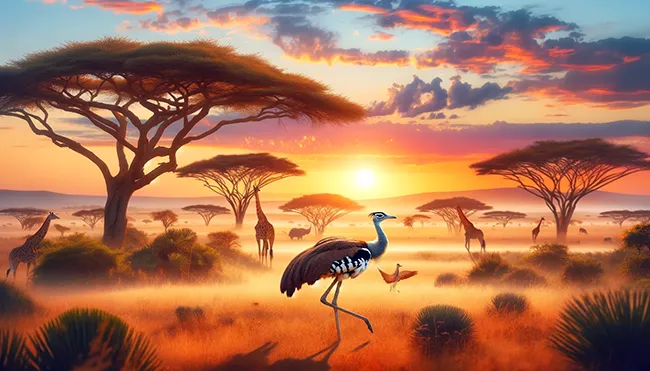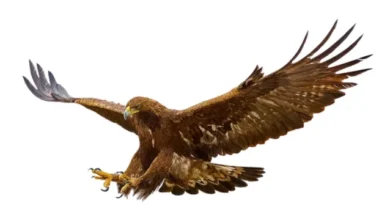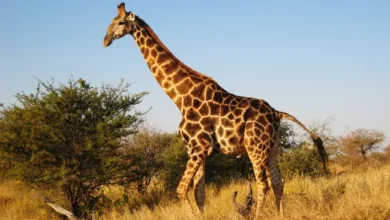
When you think about big birds that can fly, you might first think of eagles and hawks. But the heaviest flying birds are actually quite different. They include birds that live on the ground and birds that live near water. These big birds need to fly to stay safe, find food, or move to warmer places. Let’s find out who the top heaviest bird in the world that can fly. We’ll learn how big they are, what they look like, and where they live.
1. Kori Bustard (Ardeotis kori)
The Kori Bustard, one of the heaviest flying birds, can weigh up to 19 kg (42 lbs) and is recognized by its grey, brown, and white plumage, along with long legs and a distinctive neck. These birds inhabit the savannas and dry grasslands of Sub-Saharan Africa, thriving in open areas where they forage on the ground. As omnivores, their diet includes insects, small animals, and plants. Despite their size, Kori Bustards are capable of flight, though they prefer to walk and only take to the air when absolutely necessary. Currently classified as Near Threatened, they face threats from habitat destruction, hunting, and human disturbance. Conservation efforts aim to protect their natural habitats and reduce the impact of human activities on their populations.
2. Great Bustard (Otis tarda)
The Great Bustard (Otis tarda) is another giant among flying birds, notable for its unique appearance, with males significantly larger than females, sometimes weighing over 20 kg (44 lbs), making them one of the heaviest birds capable of flight. Their plumage is a mix of brown, white, and black, aiding camouflage in their natural habitat. They are found across Europe and Asia, stretching from Spain and Portugal in the west, through central Europe, and into China and Mongolia in the east. Great Bustards prefer open landscapes like grasslands and agricultural fields where they can feed on plants, seeds, insects, and small vertebrates. They exhibit interesting social behaviors, particularly during mating seasons when males display elaborate rituals to attract females. The species faces threats from habitat loss due to agricultural practices, hunting, and collisions with power lines. Classified as Vulnerable, conservation efforts for the Great Bustard include habitat management, legal protection, and reintroduction programs in areas where they have disappeared.
3. Trumpeter Swan (Cygnus buccinator)
The Trumpeter Swan (Cygnus buccinator) stands out with its impressive size and elegant white plumage, making it the largest native waterfowl species in North America. Adults can weigh up to 12 kg (26 lbs), with a wingspan that can reach over 2 meters (6.6 feet), characterized by their long necks and black bills. They inhabit large, open wetlands, lakes, and rivers across North America, with significant populations in Alaska, Canada, and the northern United States. During winter, they migrate to coastal and southern freshwater areas.
Their diet primarily consists of aquatic plants, which they access by dipping their long necks into water bodies. They also consume small fish, insects, and grain from agricultural fields. Trumpeter Swans are known for their strong pair bonds and family connections, often seen in small family groups. Their social behavior includes vocal communications, with their loud, trumpet-like calls giving them their name.
The conservation status of the Trumpeter Swan has seen significant improvements. Once near extinction due to hunting and habitat loss, efforts such as habitat restoration, protection laws, and reintroduction programs have helped their populations recover. However, they still face challenges from lead poisoning, habitat destruction, and climate change, requiring ongoing conservation efforts to ensure their survival.
4. Mute Swan (Cygnus olor)
The Mute Swan (Cygnus olor) is known for its beautiful white feathers, orange bill with a black base, and a gracefully curved neck. These large birds, weighing up to 12 kg (26 lbs) with a wingspan up to 2.4 meters (8 feet), are found across Europe, Asia, and in introduced populations in North America, favoring calm freshwater environments. They mainly eat aquatic vegetation and are known for being territorial, especially during breeding season. While considered invasive in some regions where they pose ecological challenges, Mute Swans face habitat loss and pollution in their native habitats. Conservation efforts vary, focusing on habitat protection in their natural range and managing their impact in areas where they are introduced.
5. Whooper Swan (Cygnus cygnus)
The Mute Swan (Cygnus olor) is known for its beautiful white feathers, orange bill with a black base, and a gracefully curved neck. These large birds, weighing up to 12 kg (26 lbs) with a wingspan up to 2.4 meters (8 feet), are found across Europe, Asia, and in introduced populations in North America, favoring calm freshwater environments. They mainly eat aquatic vegetation and are known for being territorial, especially during breeding season. While considered invasive in some regions where they pose ecological challenges, Mute Swans face habitat loss and pollution in their native habitats. Conservation efforts vary, focusing on habitat protection in their natural range and managing their impact in areas where they are introduced.
6. Dalmatian Pelican (Pelecanus crispus)
The Dalmatian Pelican (Pelecanus crispus) stands out for its large bill, expandable throat pouch, and a wingspan up to 3 meters (10 feet), making it one of the largest freshwater birds. It inhabits shallow wetlands in southeastern Europe, Russia, and parts of Asia, with winter migrations to warmer areas. These pelicans are social, feeding on fish in flocks and breeding in colonies. They are classified as Near Threatened due to habitat loss, pollution, and human disturbance. Conservation efforts focus on protecting their habitats and breeding sites to secure their future.
7. Wandering Albatross (Diomedea exulans)
The Wandering Albatross (Diomedea exulans) is famous for its massive wingspan of up to 3.5 meters (11.5 feet), making it the bird with the largest wingspan. It lives mostly at sea, gliding over the Southern Ocean, and only lands on remote southern islands to breed. Its diet includes squid and fish, caught during extensive flights over the ocean. The species is vulnerable due to threats like longline fishing bycatch, plastic pollution, and overfishing affecting their food sources. Conservation efforts focus on safer fishing practices and protecting breeding sites to help secure the future of these remarkable birds.
8. Harpy Eagle (Harpia harpyja)
The Harpy Eagle (Harpia harpyja), with its impressive size, strength, and agility, stands as one of the most powerful birds of prey in the world. This eagle has a body length of up to 1 meter (3.3 feet) and a wingspan of up to 2 meters (6.6 feet), characterized by its broad, strong wings and large talons, which it uses to snatch prey.
Native to Central and South American tropical rainforests, the Harpy Eagle prefers dense forest canopies where it can fly agilely in pursuit of its prey. Its range covers from Mexico, through Central America, and into South America as far south as Argentina.
The Harpy Eagle’s diet primarily consists of tree-dwelling mammals such as sloths and monkeys, demonstrating remarkable hunting skills. It waits silently in the canopy before launching a swift, powerful attack on unsuspecting prey.
However, the Harpy Eagle is facing threats from deforestation, leading to habitat loss and fragmentation. This has resulted in a decline in their populations, classifying them as Near Threatened. Conservation efforts are in place, focusing on habitat protection, reforestation, and educational programs to raise awareness about the species and the importance of rainforest conservation.
9. Andean Condor (Vultur gryphus)
The Andean Condor (Vultur gryphus) is recognized for its vast wingspan of up to 3.3 meters (10.8 feet) and soars across the Andes Mountains in South America. With distinctive black and white plumage and a preference for high altitudes, it plays a crucial role as a scavenger, feeding on carrion and keeping ecosystems clean. These birds, known for their long-term monogamous relationships, face threats from habitat loss, poisoning, and hunting, leading to their Near Threatened status. Conservation efforts focus on habitat protection, breeding programs, and reducing harmful pesticide use to help preserve this iconic species.
Conclusion
Exploring the world of the heaviest flying birds highlights their crucial ecological roles and the marvel of their flight abilities. These birds, from the Kori Bustard to the Andean Condor, play key roles in their ecosystems, acting as scavengers, predators, and seed dispersers. Their survival hinges on effective conservation efforts, addressing threats like habitat destruction and climate change. Their remarkable ability to fly, despite their size, showcases nature’s adaptability. Protecting these avian giants ensures the preservation of biodiversity and the health of ecosystems worldwide, reminding us of the importance of coexisting with and safeguarding our natural world.




